One of the most unusual places we’ve ever wanted to go on
any of our trips was to a cemetery. However, Guayaquil had the biggest cemetery
in South America and it was known as La
Ciudad Blanca or the White City for its rows of dazzling white tombs. Lonely Planet cautioned visitors exploring La Ciudad Blanca to
take a taxi there because it was in a rough area and not to wander around even during
the day because of safety concerns. Fabrizio,
our guesthouse owner’s son, again suggested we pay him to drive us there rather
than taking a taxi.
That was fine with us but we didn’t realize at the outset
that he would accompany us while we walked through the cemetery. We likely
would have spent an hour or so wandering around the massive area but Fabrizio
got caught up in the excitement of being there and discovering for the first
time many of the most notable people buried there. As a result, we ended up spending well
over two hours there!
It was staggering seeing literally thousands of vaults containing people's bodies. It wasn't quite what we were expecting or used to when visiting a cemetery.
Fabrizio pointed out how Ecuadorans love American names as
evidenced by so many familiar names on many of the tombstones.
George Washington ...!And another George Washington ...!
This monument was in honor of Julio Laurido, known as the Songbird of America and apparently, a
heartthrob in his time. People across the country mourned his death, Fabrizio
said.
Fabrizio stated that the reason there were unmarked tombs
amid the others was because families essentially rented the tombs for a certain
length of time and then the bodies were removed. Those spaces were then available for rent by
others.
Fabrizio mentioned that it was usual for a child to be given
multiple names. The first name was given at birth, followed by the father’s surname and
the mother’s surname.
This was the final resting place for the nuns of the St.
Vincent de Paul Society.
It seemed we couldn't get away from another reference to Simon Bolivar, the famous South American liberator. We had seen squares and monuments named after him throughout Panama, Colombia and now here in Guayaquil, Ecuador!
It was unbelievable seeing how huge the cemetery was. I knew
of course we’d be seeing the White City which meant by definition it was big
but it was enormous.
As this was Fabrizio’s first time viewing this tomb up
close, he got pretty excited about it. It didn’t take much for him to get
excitable, however!
This tree had beautiful blooms.
I was surprised how many of the tombs had Chinese names as I
hadn't been aware of a significant Asian community in Ecuador.
What a grand entrance way to the cemetery this must have once been. The blue and white city flag of Guayaquil is in the background on the right.
The juxtaposition of extreme wealth and the poverty in the cemetery was very apparent as some of the poorer residents of Guayaquil were only remembered with wooden crosses.
This area reminded both of us about the Hill of Crosses in
Siauliai, Lithuania that we’d visited at the beginning of our trip last fall.
A tomb for another former president, Vicente Rocafuente. Altogether, five presidents were buried in the White
City.
Steven and his souvenir, a massive leaf he picked up off the ground. Luckily, he chose to discard it moments later!
Fabrizio was so excited finding some of the most famous
tombstones that he’d never seen before either. He was thrilled to share his
discovery of them with us and we didn't want to dampen his enthusiasm by saying we'd seen quite enough by then even though there many other sights in the city we still wanted to discover.
The White City was an oasis of peace even though the cemetery was surrounded by busy streets on all sides. Some of the more grandiose tombstones had historical markers.
Before our first overseas trip in 2013, we decided to get our funeral arrangements taken care of including our grave markers. Steven joked that we should have ordered a tombstone like
this rather than a simple stone with our names on them!
This was the first time we’ve spotted angels supporting a
tomb.
We could smell a fragrant scent so we looked up and saw these beautiful blooms.
We were surprised when Fabrizio told us his mother had never come to the cemetery but he had been here many times, in part because his father-in-law was buried there. He went up and down row after row back near the entrance looking for the tombstone but couldn’t find it. I was glad his wife wasn’t there to see Fabrizio looking in vain for it!
The security guard at the entrance spoke almost perfect English having lived in Brooklyn for years before his wife was deported because she was an illegal alien. That was the first time we had ever come across someone whose family member had faced deportation.
Steven and I didn’t find our visit to the cemetery at all
depressing or macabre but rather another way to understand a part of Guayaquil’s
history. In hindsight, we would have been absolutely safe wandering through the cemetery by ourselves as there were only one or two locals there and a few workers but having Fabrizio along provided a local insight.
Next post: More of Guayaquil's Sights.
Posted on November 3rd, 2017, from Arequipa, Peru, also called the White City interestingly enough!





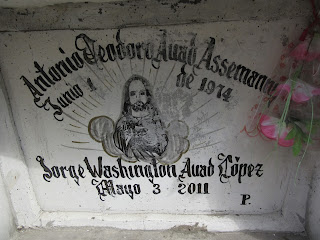



















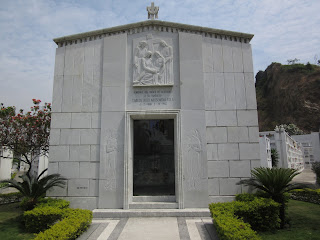






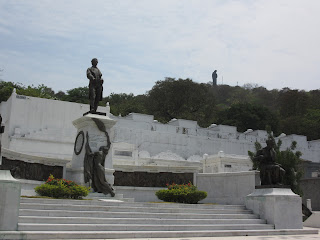













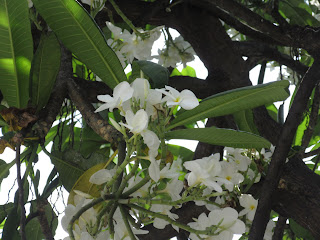


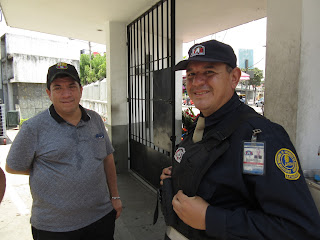

Although, I have been to some cemeteries in the states and in Israel, the emotion of feeling peoples love ones pass on from this world still weighs on the heart. The cemetery look really beautiful.
ReplyDeleteHadassah,
ReplyDeleteYou hit the nail on the head when you expressed so eloquently about how people convey their emotions for loved ones who have passed on. Having Fabrizio there to show us the many historical and personal graves made the cemetery 'come to life' for us.
Take care,my dear and give a hug to our Zachary!